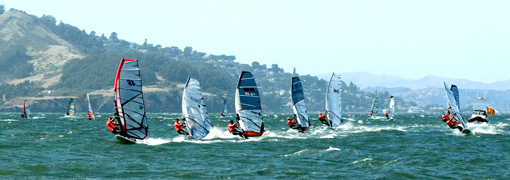Look out over the Bay on any given day and you’ll likely spot a variety of watercraft: Massive, hulking container ships entering through the Golden Gate en route to docks in Oakland, cruise ships full of tourists bound for Fisherman’s Wharf, ferries, Coast Guard cutters, sailboats, and catamarans. Zipping among them like meteors are tiny vessels that seem to be all sail and no hull. Barely twelve feet long and with masts about fifteen feet high, they plane over the waves at speeds of thirty miles per hour and more.

David Wells leads the pack competing in the U.S. Windsurfing Nationals, August 10, 2007, San Francisco. Photo by Scott Hargis Photography
By Scott Hargis
Published: September, 2007
Invented right here in California (where else?) in the sixties, windsurfing came into its own as a recognized sport in the seventies, then ballooned in popularity in the eighties and nineties as technology made lighter, more easily controlled boards available at lower prices. Today’s competitive windsurfing rigs feature carbon-fiber masts, computer-designed boards, and cutting-edge polymer sails, enabling the little craft to perform aerobatic jumps and achieve the thrilling speeds that continue to attract fans and participants around the world.
Windsurfing aficionados say that this form of sailing puts one in the closest possible contact with the wind and water, requiring constant concentration and a high degree of skill. When you add the factors of racing through a defined course, you get the watersport equivalent of Formula One racing, complete with wrecks, charismatic personalities, and plenty of action.
This year’s U.S. Windsurfing Nationals, held in San Francisco August 7th through 11th, did not disappoint. Hosted by the St. Francis Yacht Club, the five-day event featured slalom, sprints, and long distance courses of 14 miles. With great weather and sailing conditions, the races were held in front of Crissy Field; spectators were treated to world-class sailing and tactics, as the highly variable winds created challenges for even the most experienced riders.
Competitors came from around the world for this premier event, but the field was dominated by the Bay Area’s extremely strong fleet of riders, including Steve Sylvester, who at age 60 finished fourth overall, and Seth Besse, a San Francisco resident who won the overall title.
Besse, a crowd favorite, reportedly dislocated his shoulder while training for the slalom, rode back to the beach, re-set the shoulder, and then went back into the water to continue riding. His doctor had forbidden him from competing in the Nationals, but he disregarded the advice and rode to a first-place finish, winning nine of the ten Formula races. I probably could have taken the other one, but I got conservative. (Whatever else one might say about Seth, conservative would not be the first term to come to mind.)
On Thursday the 9th, Besse won the Long Distance race, which took the riders from the Golden Gate to the Bay Bridge, back to Treasure Island and then along the San Francisco waterfront to the finish at Crissy Field. Besse’s time was 34 minutes for the 14-mile course, an average of almost 25 mph! He was followed by Steven Bodner and Eric Christianson.
A collision between Bay Area local Soheil Zahedi and Christophe Waerzeggers of Belgium occurred near Treasure Island; the crash took a chunk out of Waerzegger’s board and bloodied Zahedi’s foot. Both men finished the race, and Zahedi said he planned to remove the remaining carbon fibers from his foot himself and continue racing the next day. Interviewed on shore later, both men had already made arrangements to have their boards repaired in time for the next day’s start.
Bloody collisions are not the norm, however. Tactics and endurance are key factors in any race. Windsurfers use different-sized sails for different wind conditions, and choosing the right rig for the day is important. Once the race is underway, the top riders are constantly working the wind, maneuvering to block each other’s wind, and jockeying for position around turns. At the high speeds and winds these riders encounter, broken rigs are common, and several competitors reported dealing with equipment failures on the course.
With winds of up to 35 knots on the final day of racing, the fleet was exhausted but happy, and looking forward to an awards party and meal. The next major windsurfing event is the Olympic Trials in Long Beach, which takes place October 3rd – 14th.

Royce Yen competes in the U.S. Windsurfing Nationals, August 10, 2007, San Francisco. The event was hosted by the St. Francis Yacht Club, which can be seen in the background. Photo by Scott Hargis Photography

